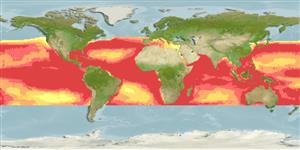Classification / Names
Common names from other countries
Main reference
Size / Weight / Age
Max length : 430 cm TL male/unsexed; (Ref. 26938); common length : 360 cm TL male/unsexed; (Ref. 13562); max. published weight: 152.4 kg (Ref. 40637); max. reported age: 35 years (Ref. 31395)
Length at first maturity
Lm 225.0, range 200 - 273 cm
Environment
Marine; brackish; pelagic-oceanic; oceanodromous (Ref. 51243); depth range 0 - 1000 m (Ref. 89972), usually 0 - 25 m (Ref. 26999)
Climate / Range
Tropical, preferred 26°C (Ref. 107945); 46°N - 31°S, 180°W - 180°E
Distribution
Circumglobal in coastal warm temperate and tropical seas (Ref. 13562). Western Atlantic: New Jersey, USA to Uruguay (Ref. 58839), including the Gulf of Mexico and Caribbean. Eastern Atlantic: western Mediterranean (Ref. 6678) to Namibia (Ref. 6812). Indo-Pacific: Persian Gulf (Ref. 68964), Red Sea, East Africa and throughout the Indian Ocean; Japan to New Caledonia, Hawaii and Tahiti. Eastern Pacific: southern California, USA to Ecuador, probably Peru.
Countries | FAO areas | Ecosystems | Occurrences | Introductions
Short description
Dorsal
spines
(total): 0;
Dorsal
soft rays
(total): 0;
Anal
spines: 0;
Anal
soft rays: 0. A large hammerhead with a notch at the center of head; 1st dorsal fin moderately high, 2nd dorsal and pelvic fins low (Ref. 5578). Front margin of head broadly arched with prominent median notch. Side wings of head narrow, rear margins swept backward (Ref. 26938). Uniform grey, grayish brown, or olivaceous above, shading to white below; pectoral fins tipped with grey or black ventrally (Ref. 13562).
IUCN Red List Status (Ref. 115185)
Human uses
Fisheries: commercial; gamefish: yes
Tools
Special reports
Download XML
Internet sources
Estimates of some properties based on models
Phylogenetic diversity index
PD50 = 0.5029 many relatives (e.g. carps) 0.5 - 2.0 few relatives (e.g. lungfishes)
Trophic Level
4.1 ±0.5 se; Based on diet studies.
Resilience
Low, minimum population doubling time 4.5 - 14 years (rm=0.028; K=0.1; tm=4-15; tmax=35; Fec=13-23)
Vulnerability
Very high vulnerability (81 of 100)
Price category
